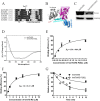A Human Disease-causing Point Mutation in Mitochondrial Threonyl-tRNA Synthetase Induces Both Structural and Functional Defects
- PMID: 26811336
- PMCID: PMC4813579
- DOI: 10.1074/jbc.M115.700849
A Human Disease-causing Point Mutation in Mitochondrial Threonyl-tRNA Synthetase Induces Both Structural and Functional Defects
Abstract
Mitochondria require all translational components, including aminoacyl-tRNA synthetases (aaRSs), to complete organelle protein synthesis. Some aaRS mutations cause mitochondrial disorders, including human mitochondrial threonyl-tRNA synthetase (hmtThrRS) (encoded by TARS2), the P282L mutation of which causes mitochondrial encephalomyopathies. However, its catalytic and structural consequences remain unclear. Herein, we cloned TARS2 and purified the wild-type and P282L mutant hmtThrRS. hmtThrRS misactivates non-cognate Ser and uses post-transfer editing to clear erroneously synthesized products. In vitro and in vivo analyses revealed that the mutation induces a decrease in Thr activation, aminoacylation, and proofreading activities and a change in the protein structure and/or stability, which might cause reduced catalytic efficiency. We also identified a splicing variant of TARS2 mRNA lacking exons 8 and 9, the protein product of which is targeted into mitochondria. In HEK293T cells, the variant does not dimerize and cannot complement the ThrRS knock-out strain in yeast, suggesting that the truncated protein is inactive and might have a non-canonical function, as observed for other aaRS fragments. The present study describes the aminoacylation and editing properties of hmtThrRS, clarifies the molecular consequences of the P282L mutation, and shows that the yeast ThrRS-deletion model is suitable to test pathology-associated point mutations or alternative splicing variants of mammalian aaRS mRNAs.
Keywords: alternative splicing; aminoacyl-tRNA synthetase; enzyme kinetics; mitochondria; mitochondrial disease; threonyl-tRNA synthetase.
© 2016 by The American Society for Biochemistry and Molecular Biology, Inc.
Figures







References
-
- Ibba M., and Soll D. (2000) Aminoacyl-tRNA synthesis. Annu. Rev. Biochem. 69, 617–650 - PubMed
-
- Schimmel P. (1987) Aminoacyl tRNA synthetases: general scheme of structure-function relationships in the polypeptides and recognition of transfer RNAs. Annu. Rev. Biochem. 56, 125–158 - PubMed
-
- Zhou X., and Wang E. (2013) Transfer RNA: a dancer between charging and mis-charging for protein biosynthesis. Sci. China Life Sci. 56, 921–932 - PubMed
-
- Lee J. W., Beebe K., Nangle L. A., Jang J., Longo-Guess C. M., Cook S. A., Davisson M. T., Sundberg J. P., Schimmel P., and Ackerman S. L. (2006) Editing-defective tRNA synthetase causes protein misfolding and neurodegeneration. Nature 443, 50–55 - PubMed
Publication types
MeSH terms
Substances
Associated data
- Actions
LinkOut - more resources
Full Text Sources
Other Literature Sources
Molecular Biology Databases
Miscellaneous

